Delving into the world of cat genetics can feel like entering a complex maze, yet it’s incredibly rewarding, especially when you start to understand how cats get their stunning coat colors. There’s a certain magic in discovering the science behind a Buff Colored Cat’s unique hue. This guide breaks down the fascinating world of feline genetics into simple, digestible terms, so you don’t need a science background to grasp the basics of how your feline friend gets its distinctive look.
A Quick Note on Genes and Alleles: For simplicity, we’ll refer to alleles (gene variations) as genes throughout this article. If you’re eager to dive deeper into the specifics of alleles, the resources at the end of this article offer further exploration into cat genetics.
The Basics of Cat Genetics
Before we explore the captivating color of buff cats, let’s lay a foundational understanding of chromosomes and genes.
Chromosomes
Much like humans, cats inherit half of their genetic blueprint from each parent. They receive 19 chromosomes from their mother and 19 from their father, totaling 38 chromosomes.
Among these, the X and Y chromosomes are crucial for determining sex. In mammals, females typically have XX chromosomes, while males have XY. Interestingly, some color-determining genes are located on the X chromosome, making these genes sex-linked, a key factor in understanding certain coat colors like buff.
Genes
Chromosomes are home to numerous genes, each playing a role in defining a living being’s characteristics, including their physical appearance. Genes come in dominant and recessive forms. Imagine it as a conversation:
A dominant gene is like a loud voice – it will express itself if inherited from just one parent. A recessive gene is quieter, only making its presence known if inherited from both parents.
Consider a cell asking, “Should I be striped or solid?”
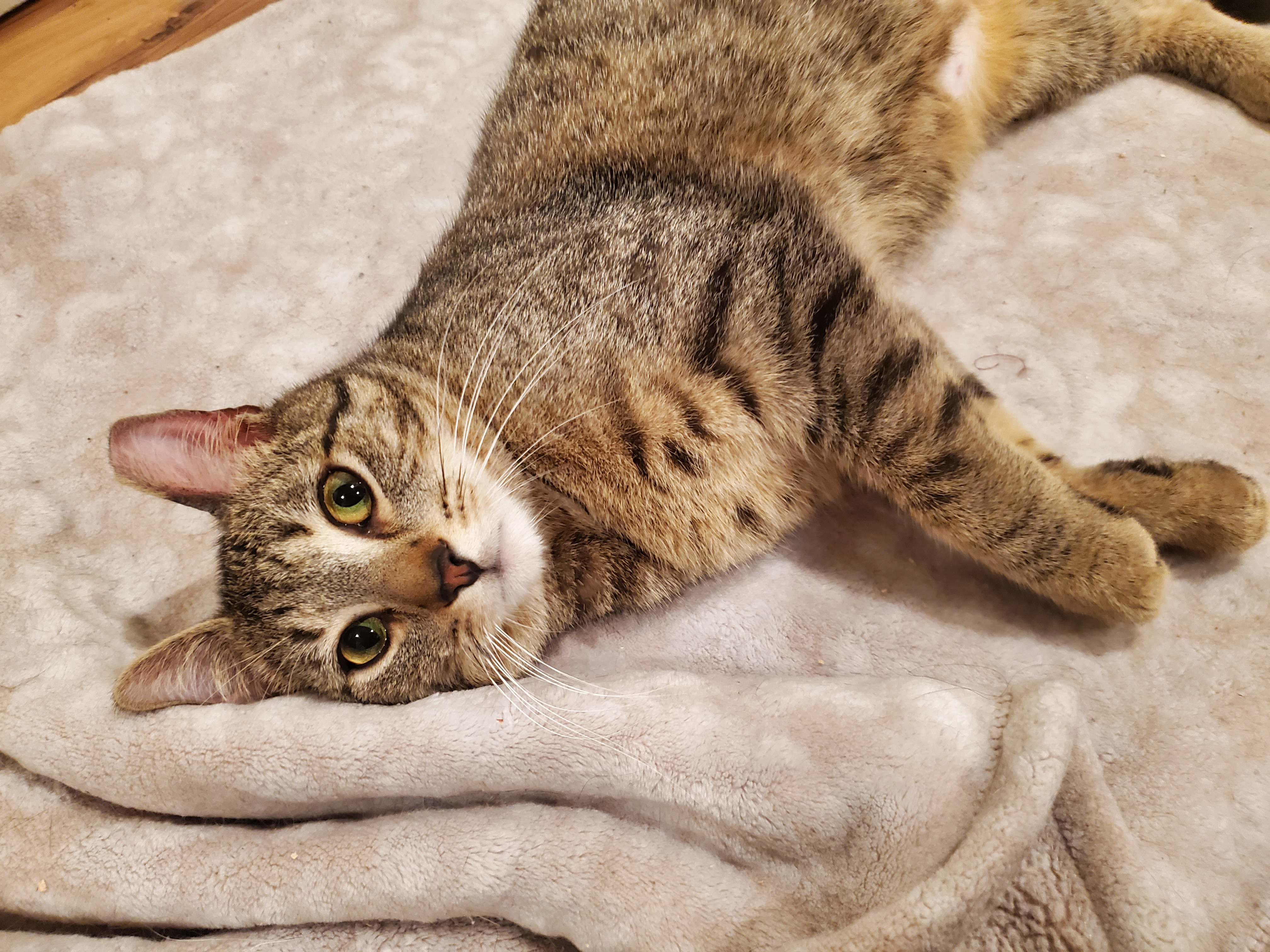 tabby cat laying on blanket
tabby cat laying on blanket
Alt text: A tabby cat with prominent stripes lounging comfortably on a blanket, illustrating the dominant striped gene expression in felines.
If the gene from the mother shouts, “Striped!” and the gene from the father whispers, “Solid,” the cell predominantly hears the dominant “striped” command. Consequently, the cat becomes striped.
With these basics in mind, we’re now ready to explore the exciting world of cat fur colors and patterns, especially how they relate to the charming buff hue.
Colors: Starting with Orange & Black
At the genetic level, all cat colors originate from just two: orange and black. The orange gene is simply orange (O), while the black gene (B) has recessive variations that can result in chocolate (b) or cinnamon (b’) coloration. For these colors to manifest in their full intensity, the dominant dense gene (D) must also be present. However, a fascinating twist occurs with another gene, leading to lighter shades of these base colors, including our focus color: buff.
The Dilute Gene: Unveiling Buff, Gray, and More
“But what about buff cats?” you might ask. “And gray cats?”
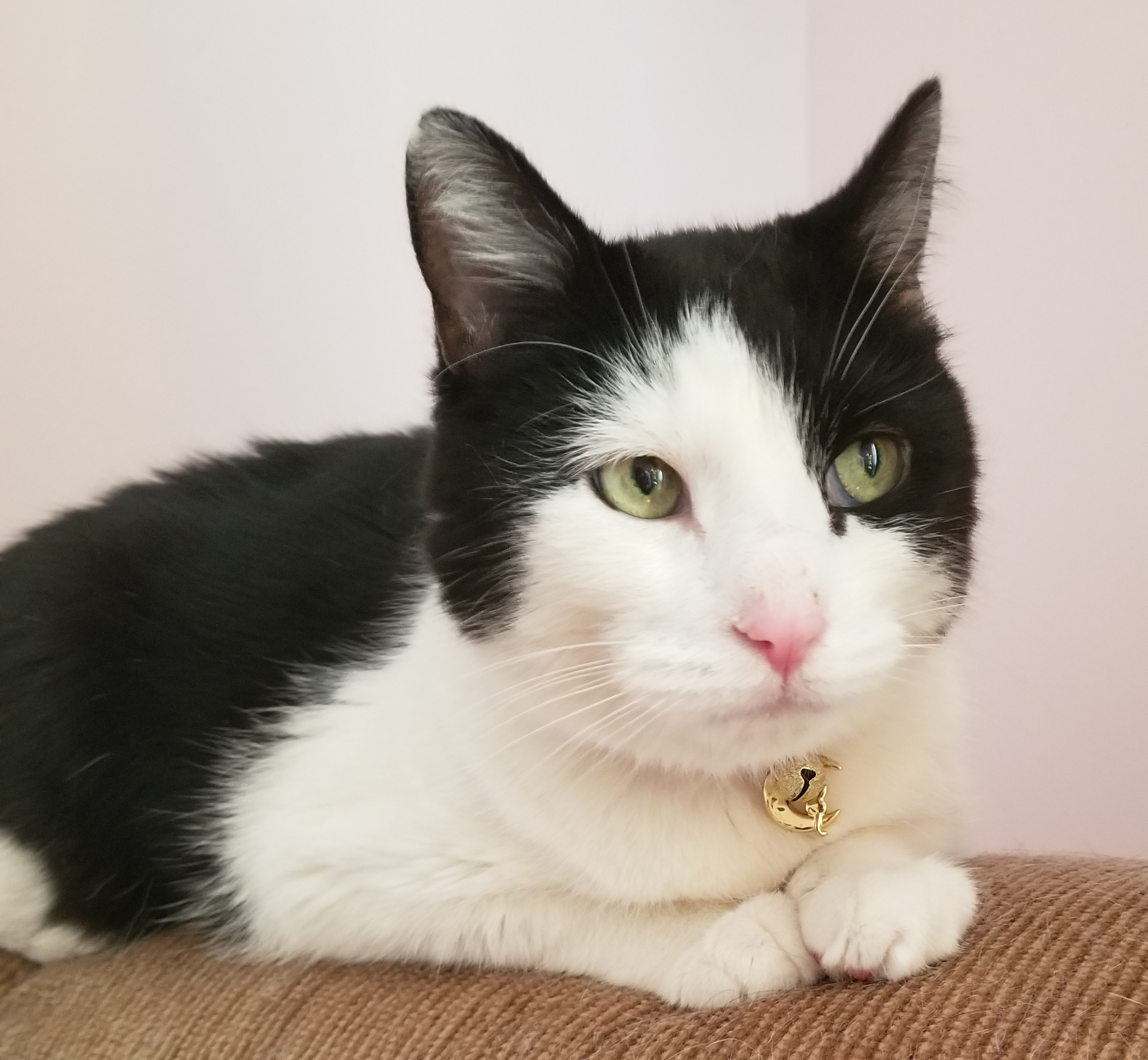 black and white cat
black and white cat
Alt text: A striking black and white cat with intense green eyes, sitting and observing, contrasting with dilute color variations like buff.
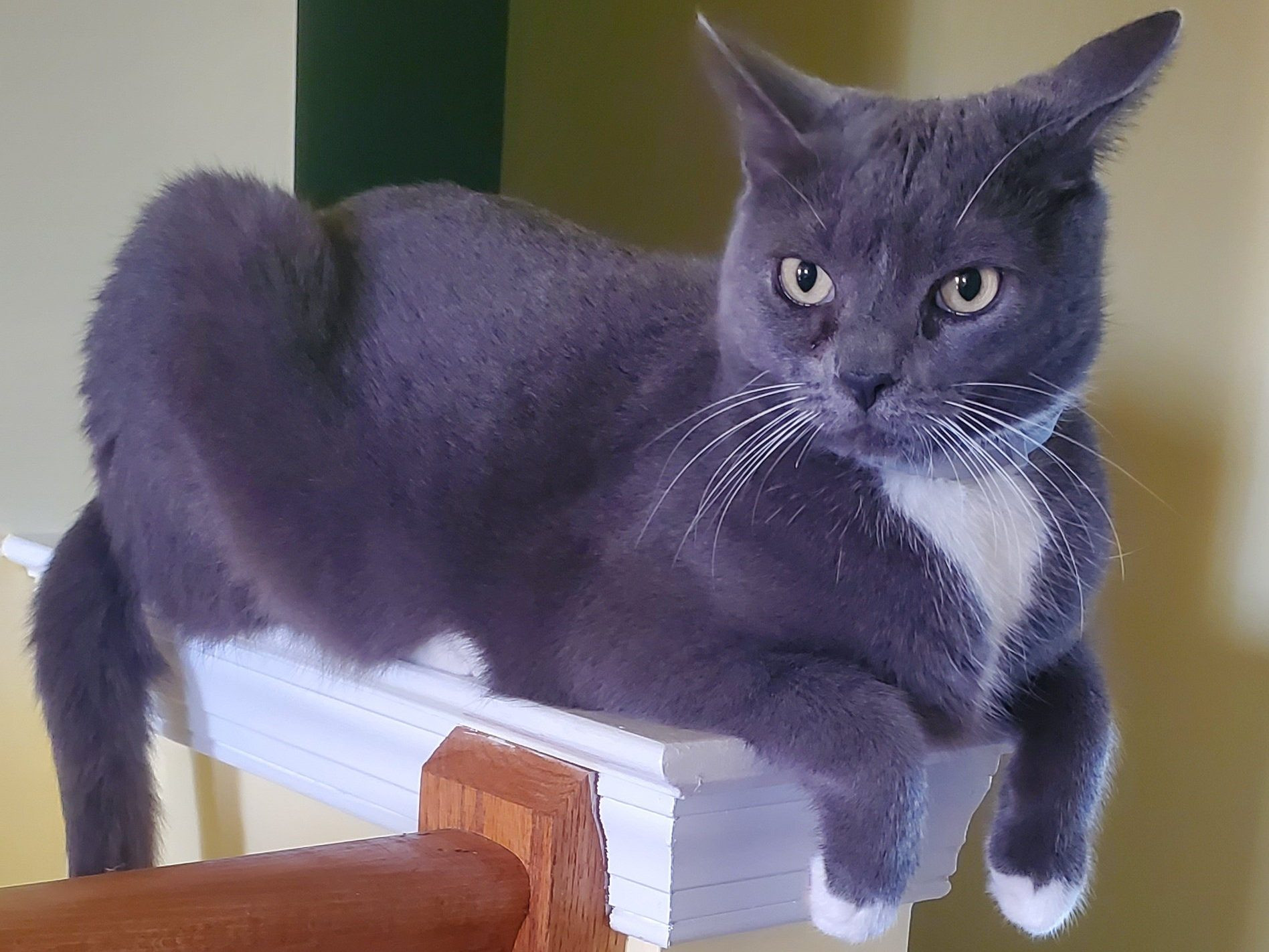 gray and white cat on perch
gray and white cat on perch
Alt text: A serene gray and white cat perched gracefully, showcasing the dilute effect on black coloration resulting in a soft gray or blue hue.
This is where the dilute gene (d) comes into play. It’s a recessive gene, meaning it must be inherited from both parents to be expressed. When a cat inherits the dilute gene, it lightens the base colors, creating a spectrum of softer shades. Here’s how the dilute gene transforms the primary colors:
- Orange turns to Cream/Buff: This is key to understanding the buff colored cat. The warm orange is softened into a gentle, creamy buff.
- Black turns to Gray/Blue: The intense black becomes a cool, soft gray, often referred to as blue in cat color terminology.
- Chocolate turns to Lilac/Lavender: Rich chocolate lightens to a delicate lilac or lavender shade.
- Cinnamon turns to Fawn/Light lilac: Warm cinnamon becomes an even paler fawn or light lilac.
 tortie cat
tortie cat
Alt text: A tortoiseshell cat displaying a mix of orange and black patches, illustrating the base colors before dilution.
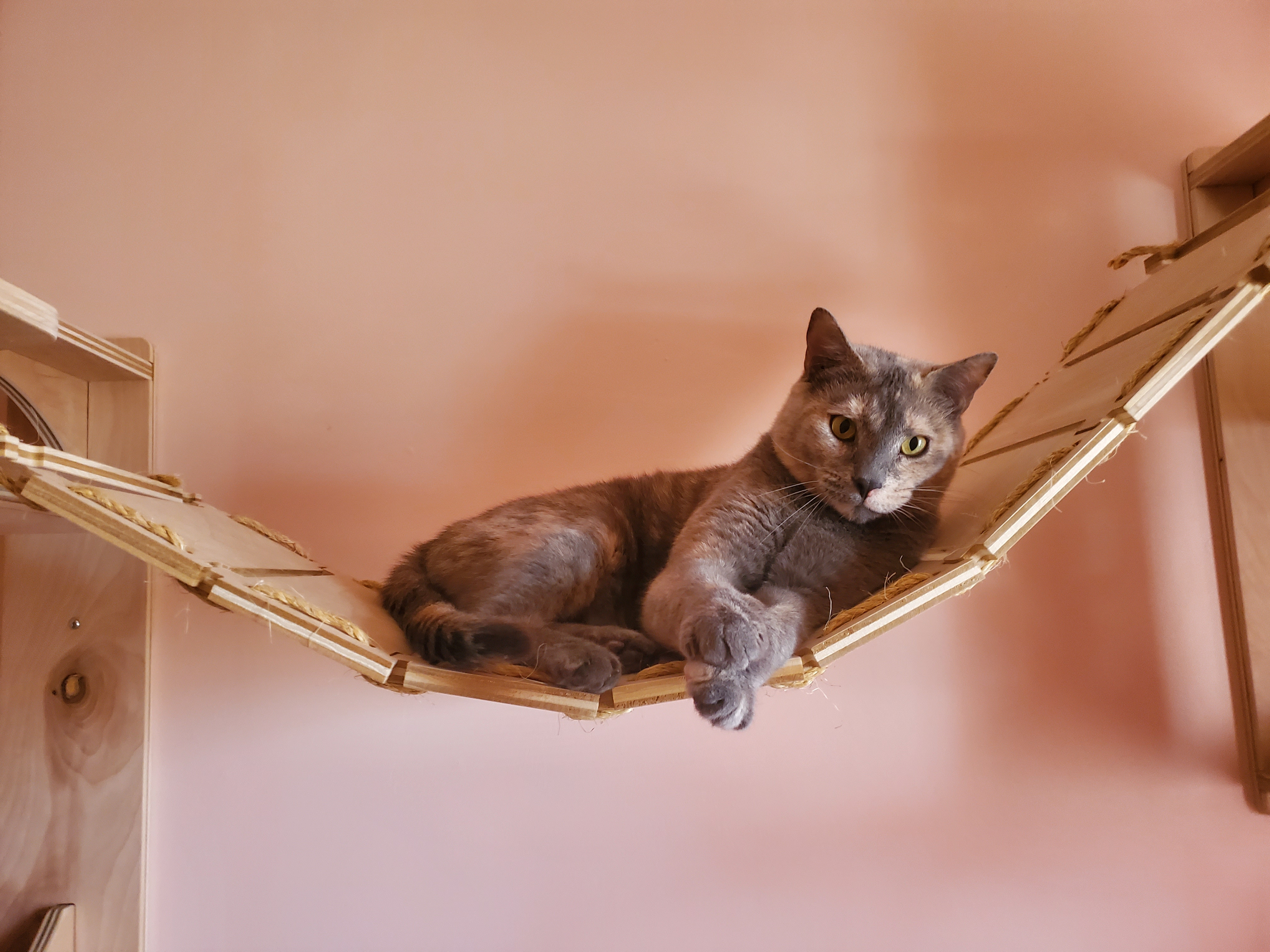 dilute tortie on walll bridge
dilute tortie on walll bridge
Alt text: A dilute tortoiseshell cat exhibiting softer cream and gray patches, demonstrating the dilute gene’s effect on a tortoiseshell pattern.
Furthermore, a dominant dilute modifier gene (Dm) can further lighten these dilute colors, though this is less common and creates even more nuanced shades like apricot from buff, and caramel from gray. However, for our buff colored cat focus, it’s the basic dilute gene that plays the most significant role in creating that lovely, soft hue.
White color in cats is a separate genetic phenomenon, which we will discuss later.
Sex-Linked Colors: The Prevalence of Buff Male Cats
As mentioned, sex chromosomes play a role in color inheritance. Females have XX chromosomes, and males have XY. The orange color gene is exclusively carried on the X chromosome, instructing cells to “Go orange” or “Go black.” The Y chromosome doesn’t carry color genes.
This is crucial for understanding why buff colored cats, which originate from the orange gene, are more commonly male.
For a female cat to be buff (or orange), she must inherit the orange gene from both parents, one on each X chromosome. Only then will her genetics signal her cells to “Go orange (or buff, if the dilute gene is also present).”
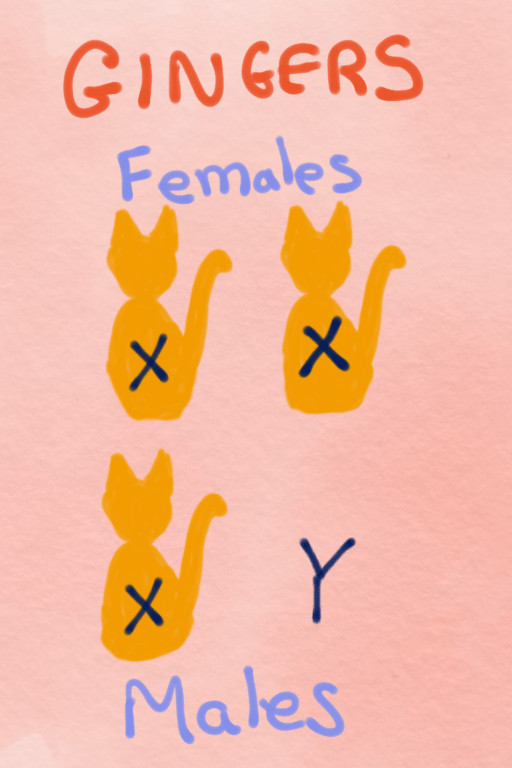 diagram of ginger cat genetics
diagram of ginger cat genetics
Alt text: Diagram illustrating ginger cat genetics, showing how the X chromosome carries the orange gene, leading to a higher prevalence of orange males because they only need to inherit one orange gene from their mother.
Since the orange color (and thus buff) is linked to the X chromosome, and males only need to inherit one X chromosome (from their mother), a male cat only needs to receive the orange gene once to become orange or buff. This is why approximately 80% of ginger cats are male, and the same principle applies to buff cats.
Calicos & Torties: Buff Variations
Female cats, with their XX chromosomes, have the genetic possibility of carrying the orange gene on one X chromosome and the black gene on the other.
This leads to an interesting question: which color becomes dominant? In this case, neither is fully dominant. When there are two X chromosomes, in each cell, only one X chromosome is activated. During embryonic development, in some cells, the “Go orange” instruction is randomly activated, while in others, “Go black” is activated. These cells then multiply, carrying their color instruction forward.

Alt text: Diagram showing embryonic cell division in tortoiseshell cats, where some cells randomly activate the orange gene and others the black gene, resulting in a patched coat.
The result is a patchwork of orange and black fur, creating a tortoiseshell cat. If the cat also carries the white spotting gene (which we’ll discuss shortly), this patchwork of color with white becomes a calico. Because this color activation is random in early development, every tortoiseshell and calico cat has a uniquely patterned coat.
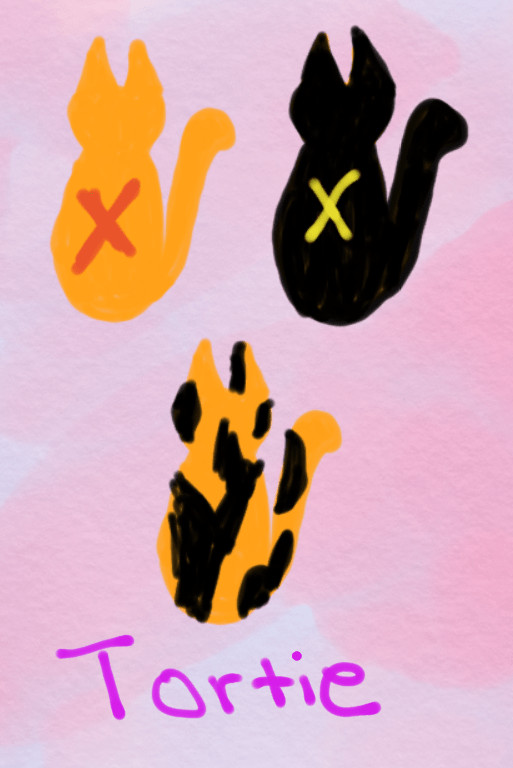 diagram of tortie cat genetics
diagram of tortie cat genetics
Alt text: Diagram explaining tortie cat genetics, illustrating how a female cat inherits an orange gene from one parent and a black gene from the other, resulting in a tortoiseshell pattern.
Now, consider the dilute gene’s effect on these patterns. A dilute tortoiseshell (“tortie”) will have patches of buff (diluted orange) and gray (diluted black). Similarly, a dilute calico will have patches of buff, gray, and white. These dilute versions showcase the buff color beautifully as part of a softer, more pastel palette.
The Rare Male Tortie or Calico: An Exception
Typically, male cats cannot be tortoiseshell or calico because they only have one X chromosome. However, in rare cases, a male cat can be born with an extra X chromosome (XXY). In such instances, if one X chromosome carries the black gene and the other carries the orange gene, a male tortie or calico is born. This is a genetic anomaly and these males are always sterile and may be prone to Klinefelter’s Syndrome, which can lead to various health issues and a potentially shorter lifespan.
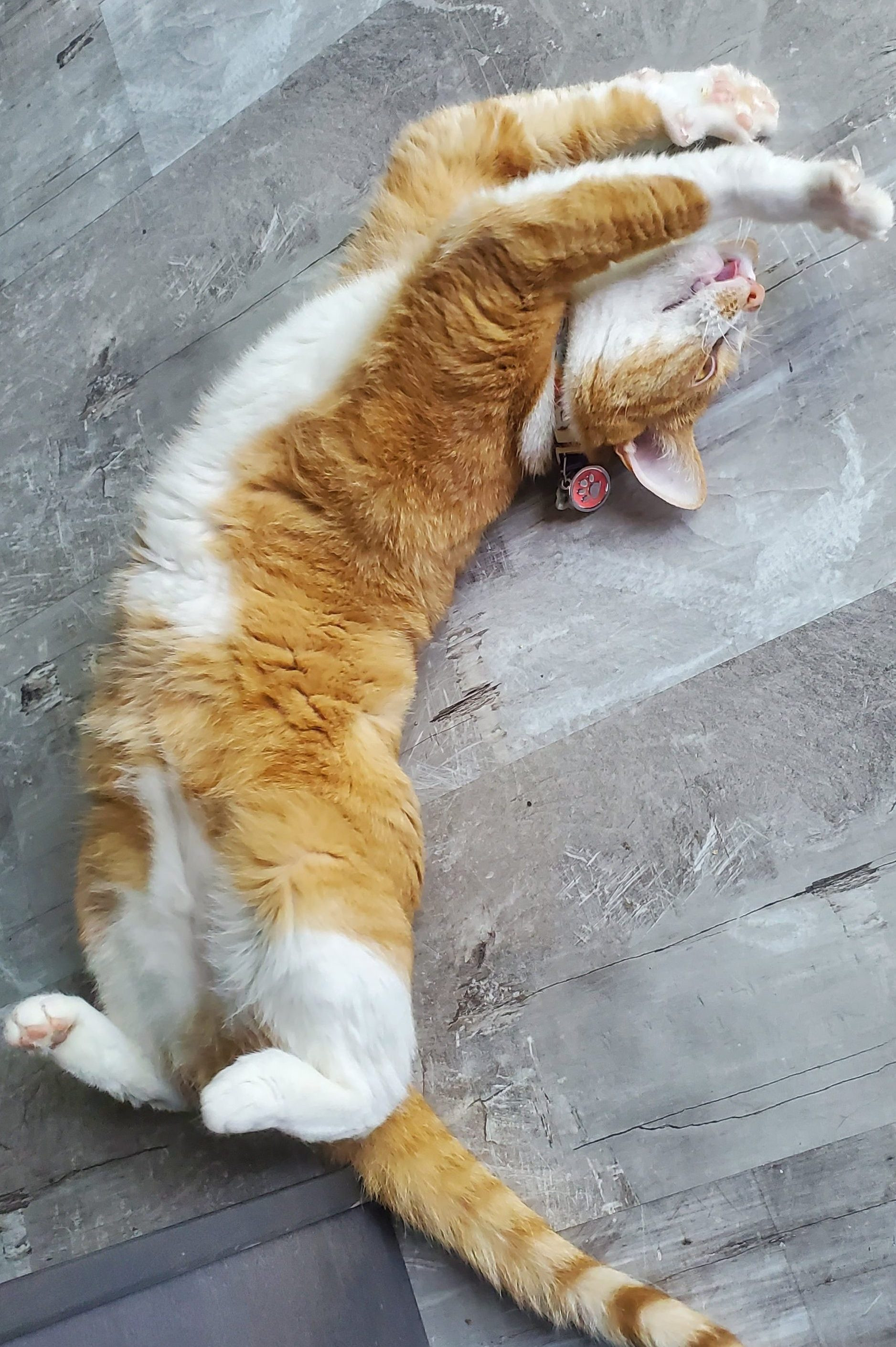 orange and white female cat
orange and white female cat
Alt text: A female orange and white cat, named Sunshine, highlighting that while most ginger or buff cats are male, females can also exhibit these colors by inheriting the orange gene from both parents, and white spotting gene for the white patches.
White Color in Cats: A Different Story
White in cats, particularly in calicos or bi-colored cats (white plus another color), comes from the white spotting gene, not the color genes we’ve discussed so far. White spotting isn’t sex-linked, so both males and females can have white markings.
White Spotting Gene
The white spotting gene (S) determines if a cat will have white patches. Here’s how it works based on the inherited genes:
- ss (recessive): No white spotting.
- Ss (heterozygous): White spotting in areas like feet, nose, chest, and tummy.
- SS (dominant homozygous): White spotting covering more than half the body, with a small chance of being completely white.
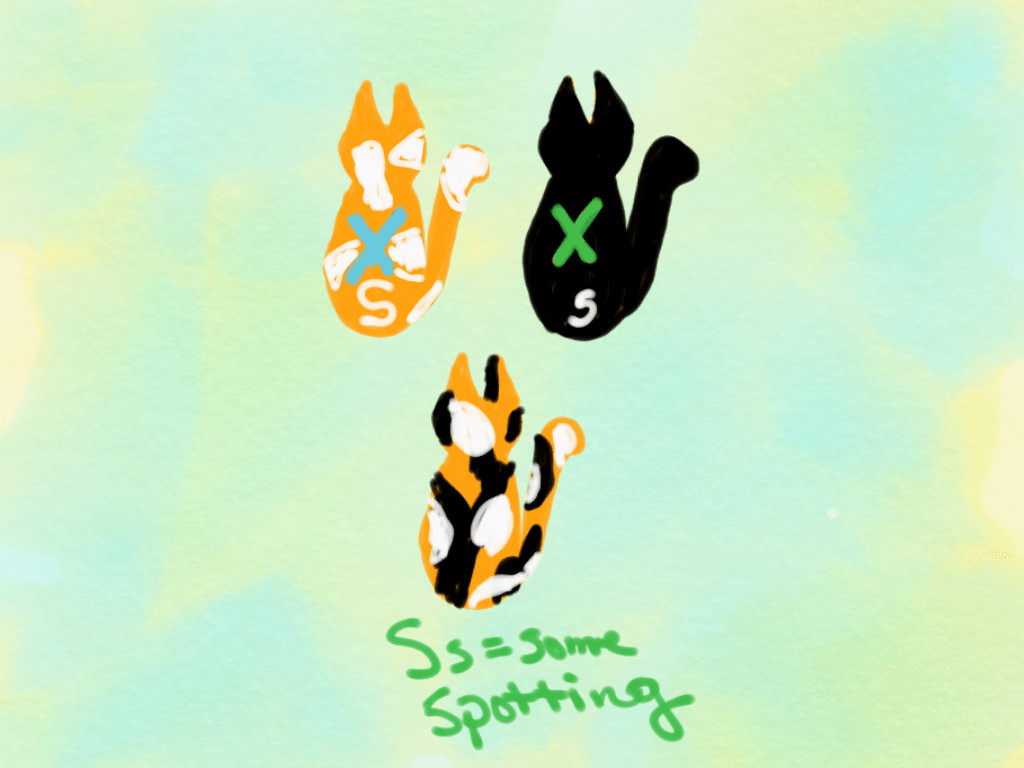
Alt text: Diagram explaining the white spotting gene in cats, showing how different combinations of the S gene result in varying degrees of white markings, from none to mostly white.
In calico cats, the white spotting gene adds white areas to the random patches of orange and black (or buff and gray in dilute calicos), creating the classic tri-color pattern.
Dominant White Gene: Masking Colors
Completely solid white cats often possess the dominant white gene (W). This gene is fascinating because it masks the cat’s actual underlying color. When a dominant white kitten is born, you might notice a few colored hairs on their head, which disappear as they mature. These “phantom” hairs reveal the cat’s true color beneath the white mask. For instance, a dominant white cat might genetically be a buff cat, but appear entirely white.
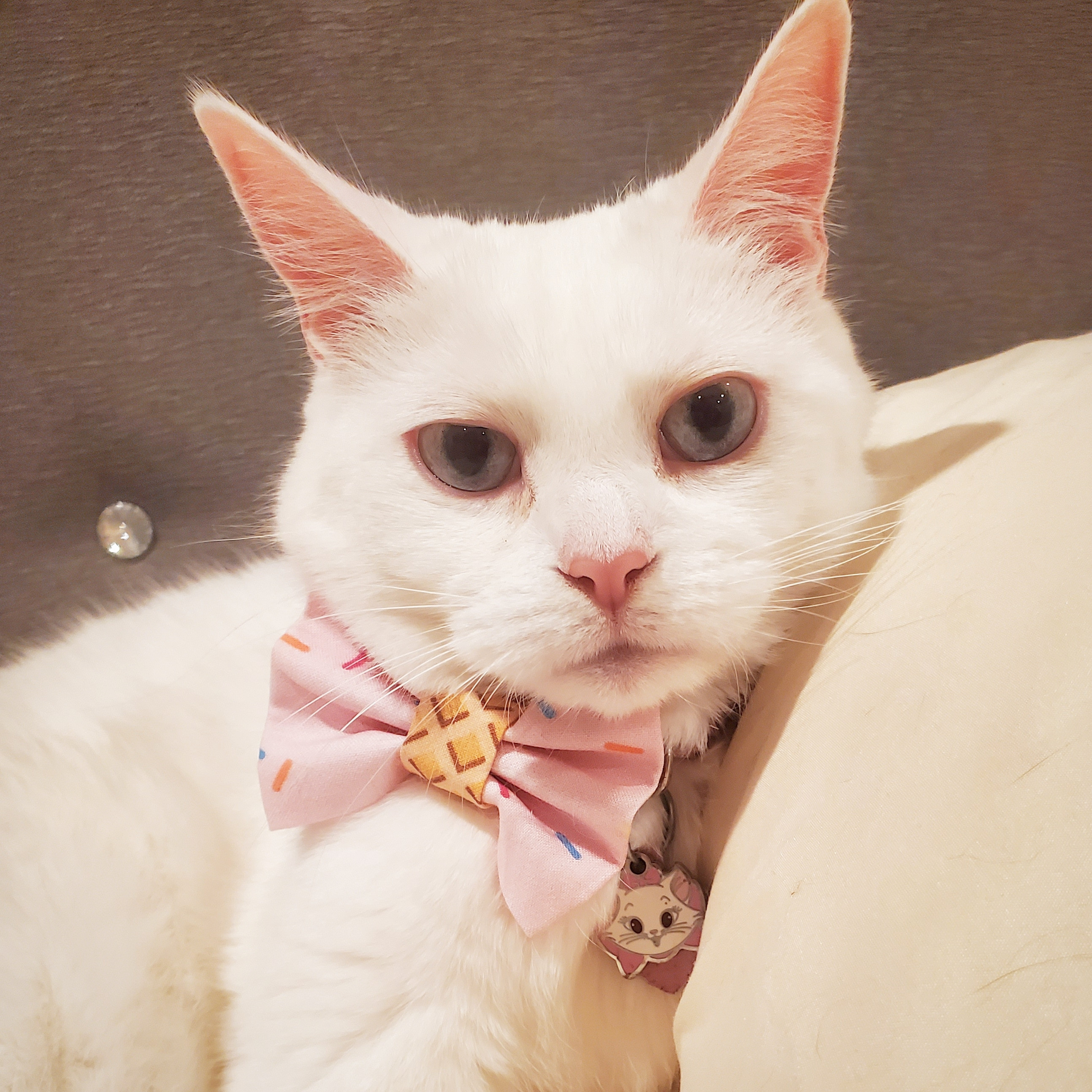
Alt text: A dominant white cat, named Dolly, with completely white fur that masks her underlying black coloration, as indicated by a few dark hairs in kittenhood.
White vs. Albino Cats
Albino cats are different from white cats. Albinism results from a missing or damaged TYR gene, which is essential for producing melanin (the pigment that gives color). Albino cats have a complete lack of pigment, resulting in pinkish skin and very pale blue eyes that can sometimes appear pinkish due to blood vessels. White cats, on the other hand, still have color genes; their white fur is due to reduced melanin production or masking genes, not a complete absence of color.
FUN FACT: Partial albinism exists and is responsible for the pointed patterns seen in Siamese, Burmese, and Tonkinese cats.
Patterns: Tabbies and Beyond
Tabbies: The Underlying Pattern
All domestic cats carry the tabby pattern in their genetic makeup, whether it’s visible or not.
The Agouti gene (A) is responsible for tabby patterns.
- A (Agouti, dominant): Creates a ticking or bands of color on each hair, resulting in a tabby pattern.
- a (non-agouti, recessive): Creates a solid-colored hair, masking the tabby pattern unless the cat is orange/buff.
A cat only needs to inherit the dominant Agouti gene (A) from one parent to display a tabby pattern, making tabby cats very common.
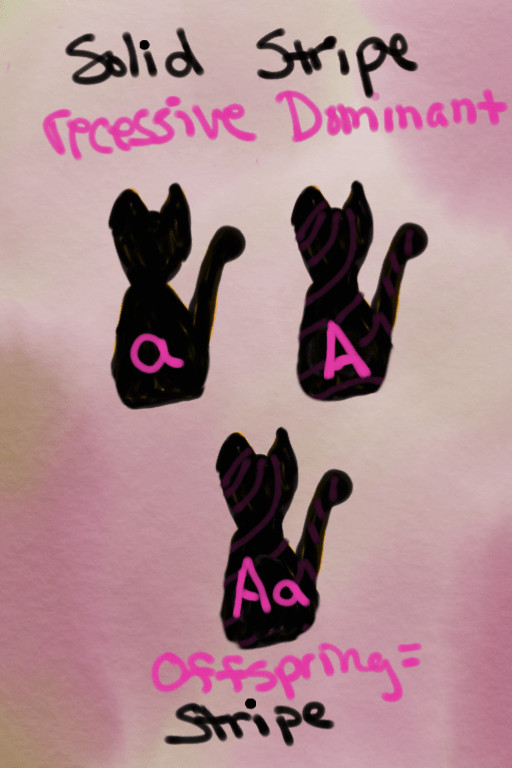
Alt text: Diagram showing tabby genetics, illustrating how inheriting the dominant agouti gene from one parent results in a tabby patterned offspring.
Even if a cat appears solid-colored, they might be an “undercover” tabby. Look closely at their tail, legs, and head in sunlight – you might see faint stripes known as ghost tabby markings. This is because the non-agouti gene (a) is recessive, and sometimes the tabby pattern still subtly shows through.
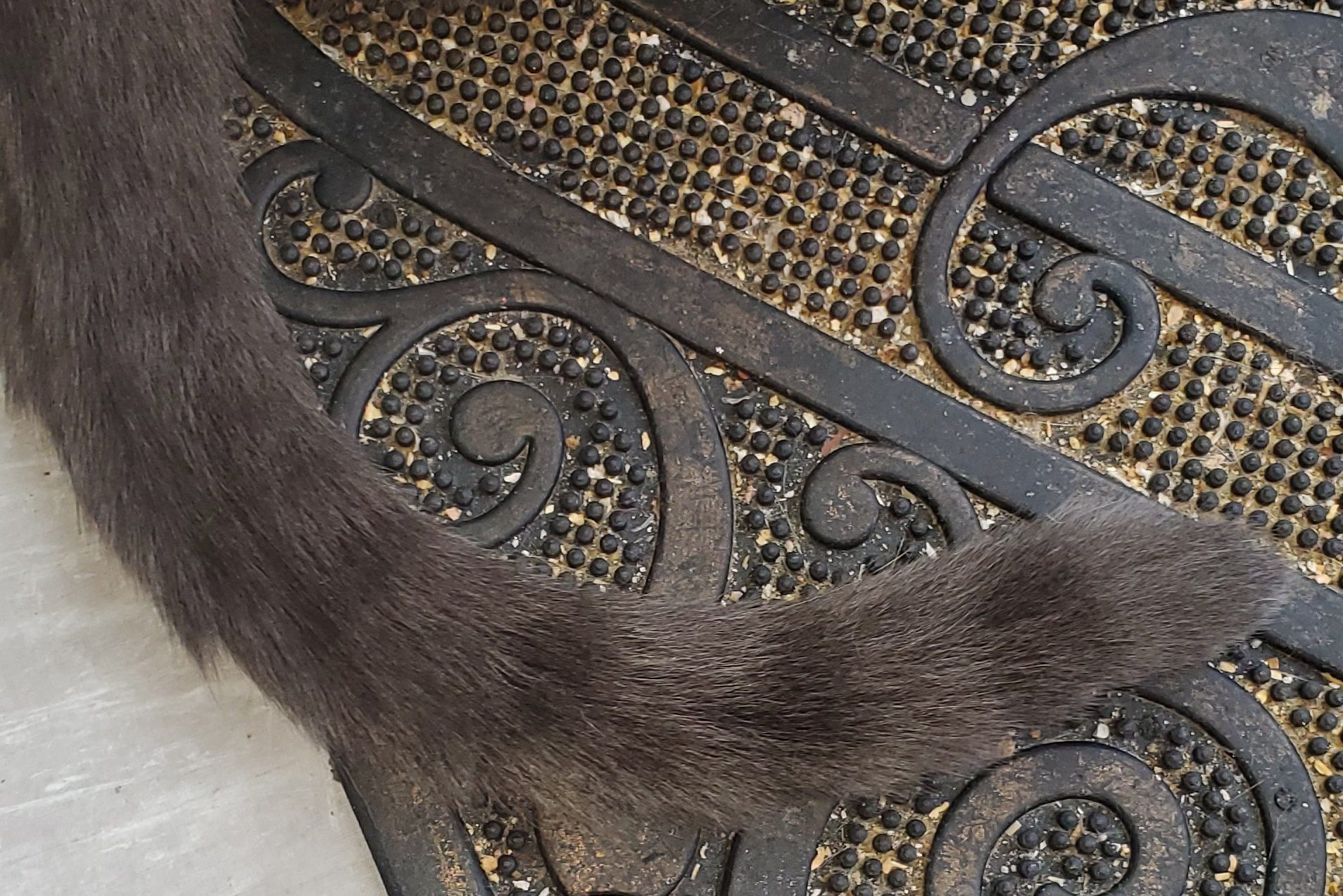 gray cat
gray cat
Alt text: A gray and white cat, named Beaker, appearing solid gray but revealing faint tabby stripes on his tail in sunlight, demonstrating ghost tabby markings.
All Buff Cats Are Tabbies
Interestingly, similar to orange cats, buff cats are almost always tabbies. Solid buff, genetically, is not typically seen. The orange gene (which leads to buff when diluted) is epistatic, meaning it masks the solid non-agouti gene. In essence, the orange/buff color gene overrules the possibility of a solid coat, always resulting in a tabby pattern beneath the buff coloration. So, your buff colored cat, with its beautiful creamy coat, is almost certainly a tabby underneath!
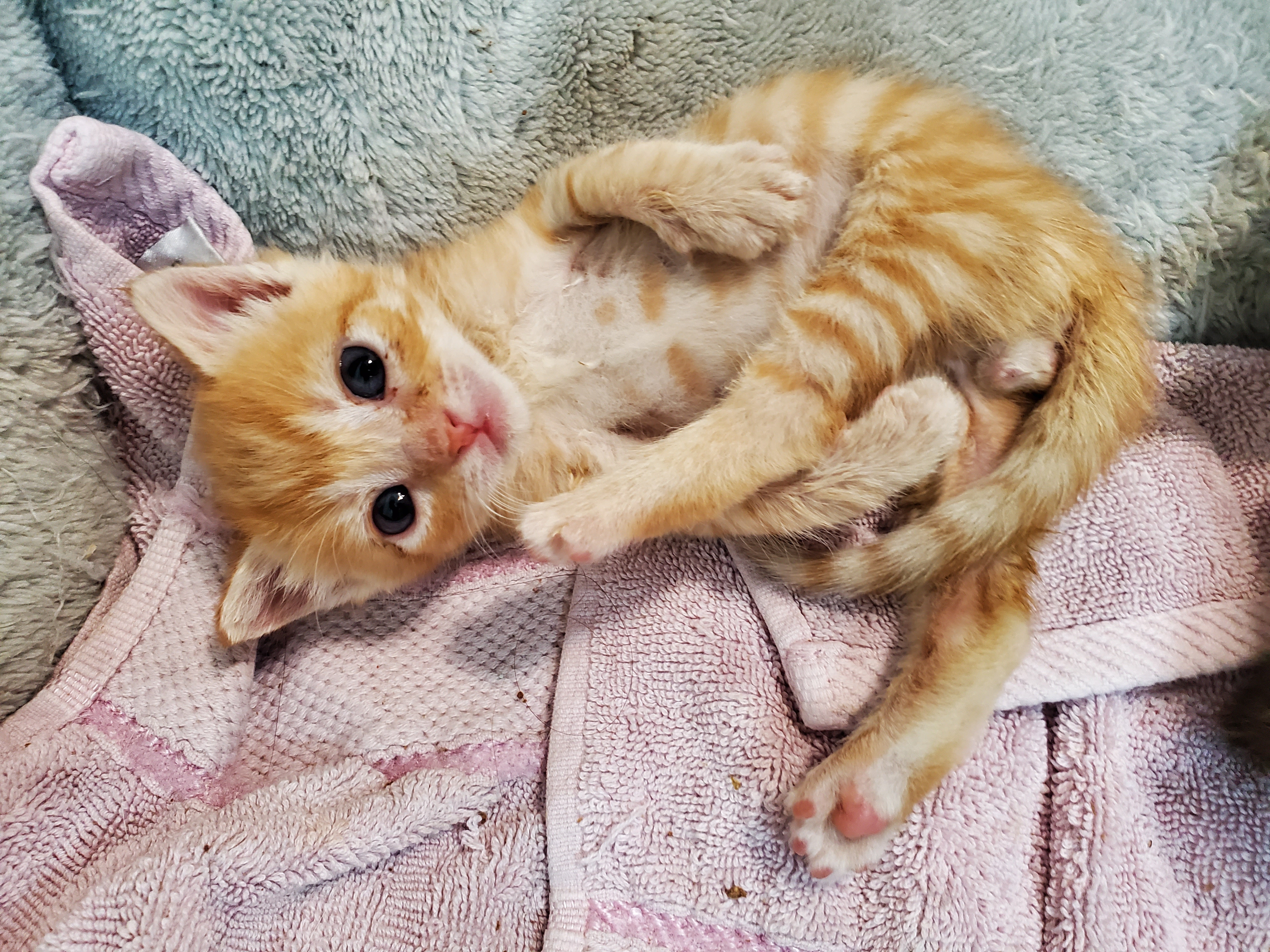 orange tabby kitten
orange tabby kitten
Alt text: An orange tabby kitten, emphasizing that 100% of orange and buff cats are tabbies because the orange gene masks the solid gene, always resulting in a tabby pattern.
You’ve Mastered Cat Coat Genetics!
Congratulations on reaching the end of this genetic journey! Understanding cat coat colors, especially the genetics behind a buff colored cat, can be complex but is incredibly fascinating. We hope this simplified breakdown has been enlightening. If you found it a bit confusing, don’t worry – cat genetics can be intricate! Feel free to explore the resources below for more in-depth information.
Learn More About Cat Genetics
Basic Genetics as Revealed by Cats, ib.berkeley.edu.
Cat Chromosome Information, by Heidi Wiesenfelder, sciencing.com.
The Genetics of Calico Cats, bio.miami.edu.


